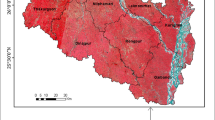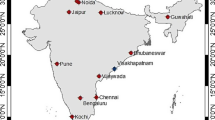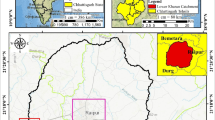Abstract
Land-use and land-cover (LULC) is an important component for sustainable natural resource management, and there are considerable impacts of the rapid anthropogenic LULC changes on environment, ecosystem services, and land surface processes. One of the significant adverse implications of the rapidly changing urban LULC is the increase in the Land Surface Temperature (LST) resulting in the urban heat island effect. In this study, we used a time series of Landsat satellite images from 1992 to 2020 in the Srinagar city of the Kashmir valley, North-western Himalaya, India to understand the linkages between LULC dynamics and LST, derived from the archived images using the Google Earth Engine (GEE). Furthermore, the relationship between LST, urban heat island (UHI), and biophysical indices, i.e., Normalized Difference Vegetation Index (NDVI) and Normalized Difference Water Index (NDWI), was also analysed. LULC change detection analysis from 1992 to 2020 revealed that the built-up area has increased significantly from 12% in 1992 to 40% in 2020, while the extent of water bodies has decreased from 6% in 1992 to 4% in 2020. The area under plantations has decreased from 26% in 1992 to 17% in 2020, and forests have decreased from 4 to 2% during the same period. Urban sprawl of Srinagar city has resulted in the depletion of natural land covers, modification of natural drainage, and loss of green and blue spaces over the past four decades. The study revealed that the maximum LST in the city has increased by 11°C between 1992 and 2020. During the same period of time, the minimum LST in the city has increased by 5°C, indicating the impact of urbanization on the city environment, which is reflected by the observed changes in various environmental indices. UHI impact in the city is quite evident with the maximum LST at the city centre having increased from 13.03°C in 1992 to 22.01°C in 2020. The findings shall serve as a vital source of knowledge for urban planners and decision-makers in developing sustainable urban environmental management strategies for Srinagar city.









Similar content being viewed by others
Data availability
The datasets used during the current study are available from the corresponding author on reasonable request.
References
Amiri R, Weng Q, Alimohammadi A, Alavipanah SK (2009) Spatial–temporal dynamics of land surface temperature in relation to fractional vegetation cover and land use/cover in the Tabriz urban area, Iran. Remote Sens Environ 113:2606–2617. https://doi.org/10.1016/J.RSE.2009.07.021
Appiah DO, Forkuo EK, Bugri JT, Apreku TO (2017) Geospatial analysis of land use and land cover transitions from 1986–2014 in a peri-urban Ghana. Geosciences 7(4):125. https://doi.org/10.3390/GEOSCIENCES7040125
Arnfield AJ (2003) Two decades of urban climate research: a review of turbulence, exchanges of energy and water, and the urban heat island. Int J Climatol 23:1–26. https://doi.org/10.1002/JOC.859
Balew A, Korme T (2020) Monitoring land surface temperature in Bahir Dar city and its surrounding using Landsat images. Egypt J Remote Sens Space Sci 23:371–386. https://doi.org/10.1016/J.EJRS.2020.02.001
Bendib A, Dridi H, Kalla MI (2016) Contribution of Landsat 8 data for the estimation of land surface temperature in Batna city, Eastern Algeria. Geocarto Int 32:503–513
Bhardwaj DR, Banday M, Pala NA, Rajput BS (2016) Variation of biomass and carbon pool with NDVI and altitude in sub-tropical forests of northwestern Himalaya. Environ Monit Assess 188:1–13. https://doi.org/10.1007/S10661-016-5626-3/TABLES/8
Bhutiyani MR, Kale VS, Pawar NJ (2007) Long-term trends in maximum, minimum and mean annual air temperatures across the Northwestern Himalaya during the twentieth century. Clim Change 85:159–177. https://doi.org/10.1007/S10584-006-9196-1
Chughtai AH, Abbasi H, Karas IR (2021) A review on change detection method and accuracy assessment for land use land cover. Remote Sens Appl 22:100482. https://doi.org/10.1016/J.RSASE.2021.100482
da Silva VS, Salami G, da Silva MIO, et al (2019) Methodological evaluation of vegetation indexes in land use and land cover (LULC) classification. Geol ecol landsc 4:159–169. https://doi.org/10.1080/24749508.2019.1608409
Dar RA, Jaan O, Murtaza KO, Romshoo SA (2017) Glacial-geomorphic study of the Thajwas glacier valley, Kashmir Himalayas, India. Quater Int 444. https://doi.org/10.1016/j.quaint.2017.05.021
Dar RA, Rashid I, Romshoo SA, Marazi A (2014) Sustainability of winter tourism in a changing climate over Kashmir Himalaya. Environ Monit Assess 186:2549–2562. https://doi.org/10.1007/S10661-013-3559-7/FIGURES/8
Dash P, Göttsche FM, Olesen FS, Fischer H (2001) Retrieval of land surface temperature and emissivity from satellite data: physics, theoretical limitations and current methods. J Indian Soc Remote Sens 29:23–30. https://doi.org/10.1007/BF02989910
Dimri AP, Mohanty UC (2009) Simulation of mesoscale features associated with intense western disturbances over western Himalayas. Meteorol Appl 16:289–308. https://doi.org/10.1002/MET.117
Duda T, Canty M (2010) Unsupervised classification of satellite imagery: choosing a good algorithm. J Soc Remote Sens 23:2193–2212
Ermida SL, Soares P, Mantas V et al (2020) Google earth engine open-source code for land surface temperature estimation from the landsat series. Remote Sens 12:1471. https://doi.org/10.3390/RS12091471
Fayaz M, Romshoo SA, Rashid I, Chandra R (2023) Earthquake vulnerability assessment of the built environment in the city of Srinagar, Kashmir Himalaya, using a geographic information system. Nat Hazards Earth Syst Sci 23:1593–1611. https://doi.org/10.5194/NHESS-23-1593-2023
Fu P, Weng Q (2016) A time series analysis of urbanization induced land use and land cover change and its impact on land surface temperature with Landsat imagery. Remote Sens Environ 175:205–214. https://doi.org/10.1016/J.RSE.2015.12.040
Garg V, Nikam BR, Thakur PK et al (2019) Human-induced land use land cover change and its impact on hydrology. HydroResearch 1:48–56. https://doi.org/10.1016/J.HYDRES.2019.06.001
Glaeser E, Henderson JV (2017) Urban economics for the developing world: an introduction. J Urban Econ 98:1–5. https://doi.org/10.1016/J.JUE.2017.01.003
Grigsby SP, Hulley GC, Roberts DA et al (2015) Improved surface temperature estimates with MASTER/AVIRIS sensor fusion. Remote Sens Environ 167:53–63. https://doi.org/10.1016/J.RSE.2015.05.019
Guha S, Govil H, Besoya M (2020) An investigation on seasonal variability between LST and NDWI in an urban environment using Landsat satellite data. Geomat Nat Haz Risk 11:1319–1345. https://doi.org/10.1080/19475705.2020.1789762
Gupta N, Aithal BH (2022) Land Surface Temperature Responses to Urban Landscape Dynamics. Handbook of Himalayan Ecosystems and Sustainability 2:249–273. https://doi.org/10.1201/9781003265160-16
Hejazi MI, Moglen GE (2008) The effect of climate and land use change on flow duration in the Maryland Piedmont region. Hydrol Process 22:4710–4722. https://doi.org/10.1002/HYP.7080
Ibrahim GRF (2017) Urban land use land cover changes and their effect on land surface temperature: case study using Dohuk City in the Kurdistan Region of Iraq. Climate 5:13. https://doi.org/10.3390/CLI5010013
IPCC (2021) Summary for policymakers — special report on climate change and land. https://www.ipcc.ch/srccl/chapter/summary-for-policymakers/. Accessed 24 Sep 2022
Jain SK, Sinha RK, Chaudhary A, Shukla S (2015) Expansion of a glacial lake, Tsho Chubda, Chamkhar Chu Basin, Hindukush Himalaya, Bhutan. Nat Hazards 75:1451–1464. https://doi.org/10.1007/S11069-014-1377-Z/FIGURES/7
Jimenez-Munoz JC, Sobrino JA, Skokovic D et al (2014) Land surface temperature retrieval methods from landsat-8 thermal infrared sensor data. IEEE Geosci Remote Sens Lett 11:1840–1843. https://doi.org/10.1109/LGRS.2014.2312032
Kusiima SK, Egeru A, Namaalwa J et al (2022) Anthropogenic induced land use/cover change dynamics of Budongo-Bugoma landscape in the Albertine region, Uganda. Egypt J Remote Sens Space Sci 25:639–649. https://doi.org/10.1016/J.EJRS.2022.05.001
Lal P, Shekhar A, Kumar A (2021) Quantifying temperature and precipitation change caused by land cover change: a case study of India using the WRF model. Front Environ Sci 9:588. https://doi.org/10.3389/FENVS.2021.766328/BIBTEX
Li W, Cao Q, Lang K, Wu J (2017) Linking potential heat source and sink to urban heat island: heterogeneous effects of landscape pattern on land surface temperature. Sci Total Environ 586:457–465. https://doi.org/10.1016/J.SCITOTENV.2017.01.191
Mahmood R, Pielke Sr RA, Hubbard KG et al (2010) Impacts of land use/land cover change on climate and future impacts of land use/land cover change on climate and future research priorities. Bull Am Meteorol Soc 91(1), 37-46.
Maimaitiyiming M, Ghulam A, Tiyip T et al (2014) Effects of green space spatial pattern on land surface temperature: Implications for sustainable urban planning and climate change adaptation. ISPRS J Photogramm Remote Sens 89:59–66. https://doi.org/10.1016/J.ISPRSJPRS.2013.12.010
Marazi A, Romshoo SA (2018) Streamflow response to shrinking glaciers under changing climate in the Lidder Valley, Kashmir Himalayas. J Mt Sci 15:1241–1253
Mathew A, Khandelwal S, Kaul N (2016) Spatial and temporal variations of urban heat island effect and the effect of percentage impervious surface area and elevation on land surface temperature: study of Chandigarh city, India. Sustain Cities Soc 26:264–277. https://doi.org/10.1016/J.SCS.2016.06.018
Matsa M, Mupepi O, Musasa T (2021) Spatio-temporal analysis of urban area expansion in Zimbabwe between 1990 and 2020: the case of Gweru city. Environmental Challenges 4:100141. https://doi.org/10.1016/J.ENVC.2021.100141
McCarthy MP, Best MJ, Betts RA (2010) Climate change in cities due to global warming and urban effects. Geophys Res Lett 37. https://doi.org/10.1029/2010GL042845
McFeeters SK (2007) The use of the normalized difference water index (NDWI) in the delineation of open water features. Int J Remote Sens 17:1425–1432. https://doi.org/10.1080/01431169608948714
McFeeters SK (2013) Using the normalized difference water index (NDWI) within a geographic information system to detect swimming pools for mosquito abatement: a practical approach. Remote Sens 5:3544–3561. https://doi.org/10.3390/RS5073544
Meraj G, Romshoo SA, Altaf S (2014) Inferring land surface processes from watershed characterization. In: Proceedings of the 16th International Association for Mathematical Geosciences—geostatistical and geospatial approaches for the characterization of natural resources in the environment: challenges, processes and strategies. Springer International Publishing, pp 430–432. https://doi.org/10.1007/978-3-319-18663-4_113/COVER
Mohamed MA, Anders J, Schneider C (2020) Monitoring of changes in land use/land cover in Syria from 2010 to 2018 using multitemporal landsat imagery and GIS. Land 9:226. https://doi.org/10.3390/LAND9070226
Murtaza KO, Dar RA, Paul OJ et al (2021) Glacial geomorphology and recent glacial recession of the Harmukh Range, NW Himalaya. Quater Int 575:236–248
Murtaza KO, Romshoo SA (2014) Determining the suitability and accuracy of various statistical algorithms for satellite data classification. Int J Geomat Geosci 4:585–599
Murtaza KO, Romshoo SA (2017) Recent glacier changes in the Kashmir Alpine Himalayas, India. Geocarto Int 32:188–205. https://doi.org/10.1080/10106049.2015.1132482
Mutanga O, Kumar L (2019) Google earth engine applications. Remote Sens 11:591. https://doi.org/10.3390/RS11050591
Njoku EA, Akpan PE, Effiong AE, Babatunde IO (2022) The effect of station density in geostatistical prediction of air temperatures in Sweden: A comparison of two interpolation techniques. Resources, Environment and Sustainability 100092. https://doi.org/10.1016/J.RESENV.2022.100092
Pawe CK (2019) The heat is on in the Himalayas: assessing Srinagar’s urban heat island effect. In: Environmental Change in the Himalayan Region: Twelve Case Studies, pp 157–171. https://doi.org/10.1007/978-3-030-03362-0_8/COVER
Peng J, Xie P, Liu Y, Ma J (2016) Urban thermal environment dynamics and associated landscape pattern factors: a case study in the Beijing metropolitan region. Remote Sens Environ 173:145–155. https://doi.org/10.1016/J.RSE.2015.11.027
Rahman MN, Rony MRH, Jannat FA et al (2022) Impact of urbanization on urban heat island intensity in major districts of Bangladesh using remote sensing and geo-spatial tools. Climate 10:3. https://doi.org/10.3390/CLI10010003
Rather MI, Rashid I, Shahi N et al (2016) Massive land system changes impact water quality of the Jhelum River in Kashmir Himalaya. Environ Monit Assess 188. https://doi.org/10.1007/s10661-016-5190-x
Romshoo SA, Altaf S, Rashid I, Ahmad Dar R (2017) Climatic, geomorphic and anthropogenic drivers of the 2014 extreme flooding in the Jhelum basin of Kashmir, India. Geomat Nat Hazards Risk 9(1):224–248. https://doi.org/10.1080/19475705.2017.1417332
Romshoo SA, Bashir J, Rashid I (2020a) Twenty-first century-end climate scenario of Jammu and Kashmir Himalaya, India, using ensemble climate models. Clim Change 162:1473–1491. https://doi.org/10.1007/S10584-020-02787-2/FIGURES/4
Romshoo SA, Fayaz M, Meraj G, Bahuguna IM (2020b) Satellite-observed glacier recession in the Kashmir Himalaya, India, from 1980 to 2018. Environ Monit Assess 192:1–17. https://doi.org/10.1007/S10661-020-08554-1/FIGURES/11
Romshoo SA, Murtaza KO, Shah W et al (2022) Anthropogenic climate change drives melting of glaciers in the Himalaya. Environ Sci Poll Res 1:1–20. https://doi.org/10.1007/S11356-022-19524-0/FIGURES/10
Romshoo SA, Rafiq M, Rashid I (2018) Spatio-temporal variation of land surface temperature and temperature lapse rate over mountainous Kashmir Himalaya. J Mountain Sci 15:563–576. https://doi.org/10.1007/S11629-017-4566-X
Romshoo SA, Rashid I (2014) Assessing the impacts of changing land cover and climate on Hokersar wetland in Indian Himalayas. Arab J Geosci 7:143–160. https://doi.org/10.1007/S12517-012-0761-9/FIGURES/14
Sahoo S, Majumder A, Swain S et al (2022) Analysis of decadal land use changes and its impacts on urban heat island (UHI) using remote sensing-based approach: a smart city perspective. Sustainability 14:11892. https://doi.org/10.3390/SU141911892
Schmidhuber J, Tubiello FN (2007) Global food security under climate change. Proc Natl Acad Sci U S A 104:19703–19708
Schmugge T, French A, Ritchie JC et al (2002) Temperature and emissivity separation from multispectral thermal infrared observations. Remote Sens Environ 79:189–198. https://doi.org/10.1016/S0034-4257(01)00272-3
Sekertekin A, Bonafoni S (2020) Land surface temperature retrieval from Landsat 5, 7, and 8 over rural areas: assessment of different retrieval algorithms and emissivity models and toolbox implementation. Remote Sens 12:294. https://doi.org/10.3390/RS12020294
Sharma AK, Pezzaniti D, Myers B et al (2016) Water sensitive urban design: an investigation of current systems, implementation drivers, community perceptions and potential to supplement urban water services. Water 8:272. https://doi.org/10.3390/W8070272
Singh SK (2016) Geospatial technique for land use/land cover mapping using multi-temporal satellite images: A case study of Samastipur District (India). Environment & We An International Journal of Science & Technology 11:75–85
Sobrino JA, Jiménez-Muñoz JC, Paolini L (2004) Land surface temperature retrieval from LANDSAT TM 5. Remote Sens Environ 90:434–440. https://doi.org/10.1016/J.RSE.2004.02.003
Surya B, Syafri S, Sahban H, Sakti HH (2020) Natural resource conservation based on community economic empowerment: perspectives on watershed management and slum settlements in Makassar City, South Sulawesi, Indonesia. Land 9:104. https://doi.org/10.3390/LAND9040104
UN (2019) World population prospects 2019: highlights | multimedia library—United Nations Department of Economic and Social Affairs. https://www.un.org/development/desa/publications/world-population-prospects-2019-highlights.html. Accessed 23 Sep 2022
Varade D, Dikshit O (2019) Improved assessment of atmospheric water vapor content in the Himalayan Regions around the Kullu Valley in India using landsat-8 data. Water Resour Res 55:462–475. https://doi.org/10.1029/2018WR023806
Wan Z (1996) A generalized split-window algorithm for retrieving land-surface temperature from space. IEEE Trans Geosci Remote Sens 34:892–905. https://doi.org/10.1109/36.508406
Wang M, Zhang Z, Hu T et al (2020) An efficient framework for producing landsat-based land surface temperature data using google earth engine. IEEE J Sel Top Appl Earth Obs Remote Sens 13:4689–4701. https://doi.org/10.1109/JSTARS.2020.3014586
Weng Q (2010) A remote sensing? GIS evaluation of urban expansion and its impact on surface temperature in the Zhujiang Delta, China. Int J Remote Sens 22:1999–2014. https://doi.org/10.1080/713860788
Weng Q (2009) Thermal infrared remote sensing for urban climate and environmental studies: Methods, applications, and trends. ISPRS J Photogramm Remote Sens 64:335–344. https://doi.org/10.1016/J.ISPRSJPRS.2009.03.007
Yang Y, Onishi T, Hiramatsu K (2015) Impacts of different spatial temperature interpolation methods on snowmelt simulations. Hydrological Research Letters 9:27–34. https://doi.org/10.3178/HRL.9.27
Yin Id S, Liu J, Han Z (2022) Relationship between urban morphology and land surface temperature—a case study of Nanjing City. PloS One 17(2):e0260205. https://doi.org/10.1371/journal.pone.0260205
Zaz SN, Romshoo SA, Krishnamoorthy RT, Viswanadhapalli Y (2019) Analyses of temperature and precipitation in the Indian Jammu and Kashmir region for the 1980–2016 period: implications for remote influence and extreme events. Atmos Chem Phys 19:15–37
Acknowledgements
The research work was conducted under Rashtriya Uchchatar Shiksha Abhiyan (RUSA), Ministry of Education, Government of India sponsored research project titled “Strengthening the Innovative Research in Geomatics, Climate Change, and Hydrology.” The financial assistance received from the sponsors under the project is thankfully acknowledged. We are thankful to USGS for providing the satellite data free for use to the general public.
Funding
The research work was conducted under Rashtriya Uchchatar Shiksha Abhiyan (RUSA), Ministry of Education, Government of India sponsored research project titled “Strengthening the Innovative Research in Geomatics, Climate Change, and Hydrology.”
Author information
Authors and Affiliations
Contributions
KOM: data curation and analysis, methodology, investigation, manuscript preparation, writing; SS: data curation, analysis and investigation; SP: data analysis and investigation; SAR: conceptualization, methodology, investigation, supervision, manuscript writing with inputs from KOM.
Corresponding author
Ethics declarations
Ethics approval and consent to participate
Not applicable.
Consent for publication
Not applicable.
Competing interests
The authors declare no competing interests.
Additional information
Responsible Editor: Philippe Garrigues
Publisher’s note
Springer Nature remains neutral with regard to jurisdictional claims in published maps and institutional affiliations.
Rights and permissions
Springer Nature or its licensor (e.g. a society or other partner) holds exclusive rights to this article under a publishing agreement with the author(s) or other rightsholder(s); author self-archiving of the accepted manuscript version of this article is solely governed by the terms of such publishing agreement and applicable law.
About this article
Cite this article
Murtaza, .O., Shafai, S., Shahid, P. et al. Understanding the linkages between spatio-temporal urban land system changes and land surface temperature in Srinagar City, India, using image archives from Google Earth Engine. Environ Sci Pollut Res 30, 107281–107295 (2023). https://doi.org/10.1007/s11356-023-28889-9
Received:
Accepted:
Published:
Issue Date:
DOI: https://doi.org/10.1007/s11356-023-28889-9




